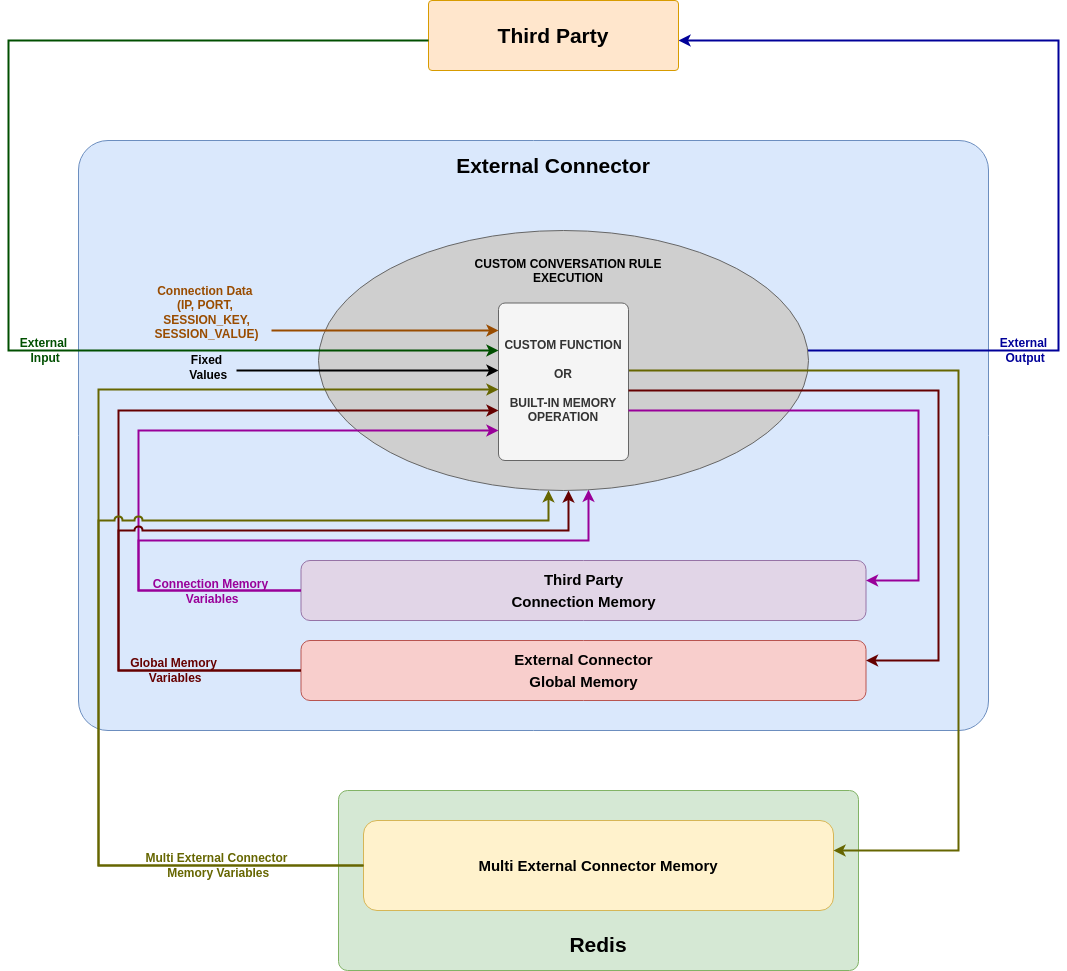12. Custom Functions¶
One of the best features that Lope provides is to allow that you can add your own Python code to expand the current capabilities already provided.
This has already mentioned in the External Connector Configuration, in the operation section of the external connector configuration
file. You need to provide the location and name of the Python module where Lope can find your own code, as explained in the preiously cited chapter.
If the custom function module can not be imported, the execution of the external connector can take place but the interactions will not use those
You can add your own code in three different ways in the interaction:
Pre-processor function: If it is used, this function is called every time a new message is received from a third party before any action of Lope. This can be interesting in interactions that you need something before executing the Lope actions. For instance, if your interaction is using a binary protocol, you should convert the binary into text based information before using Lope.
Post-processor function: If it is used, this function is called every time after Lope has something to send to third party as part of the process of replying them. This covers the need of doing something at the end of the response process. In the precious example, this can allow you to convert into binary the text Lope have already prepared.
Function in Custom Rule: Any custom rule can execute a function in the same way that it can execute a built-in memory operation, as explained in Memory Operations.
In any case, the functions called has to be called using the exact name, and you should provide the same number and in the same order of parameters as they are defined. In case of not, those not provided parameters will be autoprovided using an empty string, a ‘0’ or ‘false’, depending on the case. For the number of memory variablesfor saving the output of a function is not the same of the results the function provides, then some values will be lost. In case of providing more memory variables than results, they will remain unchanged.
Please, keep in mind that the pre-processor and post-processor will always use the ‘external input’ or ‘external output’ (depending on the preprocessor function used) as the first input and output of those functions. Therefore, you only can add additional inputs and outputs to the pre/post-processor functions. This is one of the the main differences with the normal custom functions (those called in any custom rule execution), the pre/post-processor functions have the mandatory input and output that is the ‘external input’ for the pre-processoror function, and the ‘external output’ for the post-processor function. The rest of potential inputs and outputs are optional, and can be any memory variable or fixed (hardcoded) values, or even some connection data (ip, port, the session key or session value). For the functions called from any custom rule, all the values are optional and even they can have none.
The following image represents how the pre-processor and post-processor functions work in the response process. Please keep in mind that you can use only one of those functions if needed, you do not need to use both always.

The next one represents the potential inputs of custom functions called in custom rules, or any built-in memory operations, since both work in the same way. They can use the same potential inputs and outputs, you only have to choose what you need.

As you can see in the image, there is another big difference between pre/post-processor functions and these other operations: the use of the ‘external output’. Post-processor function can use it, but these functions or memory operations they cannot: they only modify the memory variables. Depending on the configuration of when the custom functions in rules should be executed (‘rule detection’ vs ‘rule execution’), you can use the modified memory variable in the response. In case you execute the custom functions after the rule execution, the potential reply is already sent. Nevertheless, this is not an issue because if you need to do an operation and then replying to the third party, you can call the function or memory operation in the sync custom rule, and trigger an async rule to send the reply right after the sync rule. Following that idea, you can concatenate several memory operations (built-in or custom functions) as a set of async or hybrid rules (as we have already seen at the end of the Conversation Rules).
12.1. Custom Pre-processor Function¶
Once we have seen the concepts behind the use of custom functions, it is time to see how to use them. To use the pre-processor function, you have to add the following information in the
operation:
# -----------------------------------------------------------
# Operational parameters of the interation
# and connection with third parties
# -----------------------------------------------------------
operation:
# GENERAL ASPECTS
# ===============
...
# TO ENABLE TLS/DTLS USE
# ======================
...
# SOCKET CONNECTION CLOSE
# =======================
...
# SESSION SUPPORT
# ===============
...
# CUSTOM FUNCTIONS
# ================
custom_function_preprocessor:
# name of the function to call
name: testing_preprocessor
# the external input will always be the first
# input, others are defined here:
# additional
input:
- var1
- var2
- 2
- 'IP'
# In this case the input of the function is:
# ('external input', var1, var2, 2, ip value) => testing_preprocessor
# the external input will always be the first
# output, others are defined here:
# additional
output:
- var1
- var2
# In this case the output of the function is:
# testing_preprocessor => ('external input', var1, var2)
# OTHER TOPICS
# ============
# Additional aspects should be defined here, but
# they will be described in the respective sections
# of this documentation, for the sake of clarity
...
12.2. Custom Post-processor Function¶
The use of the custom post-processor is almost identical to the pre-processor function:
# -----------------------------------------------------------
# Operational parameters of the interation
# and connection with third parties
# -----------------------------------------------------------
operation:
# GENERAL ASPECTS
# ===============
...
# TO ENABLE TLS/DTLS USE
# ======================
...
# SOCKET CONNECTION CLOSE
# =======================
...
# SESSION SUPPORT
# ===============
...
# CUSTOM FUNCTIONS
# ================
custom_function_postprocessor:
# name of the function to call
name: testing_postprocessor
# the external output will always be the first
# input, others are defined here:
# additional
input:
- var1
- var2
- 'hello!'
# In this case the input of the function is:
# ('external output', var1, var2, 'hello!') => testing_postprocessor
# the external input will always be the first
# output, others are defined here:
# additional
output:
- var1
- var2
# In this case the output of the function is:
# testing_postprocessor => ('external output', var1, var2)
# OTHER TOPICS
# ============
# Additional aspects should be defined here, but
# they will be described in the respective sections
# of this documentation, for the sake of clarity
...
12.3. Custom Functions in Custom Rules¶
In contrast of the pre/post-processor functions, the functions in custom rules are defined in the rules that execute them, in the same way of the built-in memory operations. In case of a custom rule contains a built-in memory operation and a custom function, then the built-in memory operation will be executed first and later, the custom function call.
The use of the same reserver words that we have seen in Memory Operations is also applicable here:
EXT_IN: the external input from the third partyIP: the ip of the connectionPORT: the port of the connectionSESSION_KEY: the session key of the connectionSESSION_VALUE: the session value of the connection
The execution of custom function can be adjusted to decide ‘when’ takes place, as we have already seen for Memory Operations: in the ‘rule detection’ step (when the rule is
considered as applicable), or in the ‘rule execution’ step (when the rule is executed and the response is sent). This is configured in in the operation section as follows:
# -----------------------------------------------------------
# Operational parameters of the interation
# and connection with third parties
# -----------------------------------------------------------
operation:
# GENERAL ASPECTS
# ===============
...
# TO ENABLE TLS/DTLS USE
# ======================
...
# SOCKET CONNECTION CLOSE
# =======================
...
# SESSION SUPPORT
# ===============
...
# CUSTOM FUNCTIONS
# ================
# One of the following: "rule_detected", "rule_executed"(default)
custom_functions_when: rule_detected
# OTHER TOPICS
# ============
# Additional aspects should be defined here, but
# they will be described in the respective sections
# of this documentation, for the sake of clarity
...
and the way to declare the use of the custom function within a rule can be found here:
any_custom_rule:
# GENERAL FIELDS
# ==============
...
# CUSTOM FUNCTION
# ===============
custom_function:
# custom function enable for this rule?
enable: yes # yes/no(default)
name: function_name
# List of inputs
input:
- EXT_IN # 'external input'
- var1
- 3.14
# List of memory variables
# to save the results
output:
- var3
- var4
# In this example:
# ----------------
# Inputs to the custom function
# ('external input', var1, 3.14) => function_name
# Output of the custom function
# function_name => (var3, var4)
# OTHER FIELDS
# ============
# Other fields expalined in this documentation
...
